Exhaust Gas Recirculation (EGR) came about in 1975 when catalytic converters were introduced. The inert exhaust gas was used to quell the increased heat in the engine’s cylinders from the lean fuel mixtures required to keep the catalytic converters from melting down. EGR systems also helped eliminate spark knock from the increased combustion chamber temperatures. The feds were also pushing for a reduction of NOx nitrogen oxide emissions to reduce ground level ozone formation. The EGR system was an asset in many ways during the early years of emission control. As engine controls and development advanced, EGR has become obsolete for the majority of engine manufacturers. Unfortunately, there are many Corvettes on the road with EGR systems failing.
Metering the NOx inert gas was handled via a simple valve that opened when the engine was at operating temperature. When fuel injection came along EGR flow was controlled by the ECM to optimize its use. An electrically operated solenoid was used to control EGR flow as the ECM managed fuel control. EGR could not be introduced at idle, or rough idle and stalling would occur from leaning out the fuel mixture. EGR flow would only be introduced under light to moderate throttle openings, never under hard acceleration. The feds also wanted the ECM to monitor EGR flow to make sure it was working and limiting NOx exhaust emissions by 1985. They required a test at every drive cycle to assure proper function and if the system test failed a code 32 would be set in the ECM’s memory.
There were distinct differences in the way GM handled control of the EGR valve. Additionally, they used two different ways to determine if the exhaust gas flowed. All C4s used electric solenoids, some NO (normally open) or NC (normally closed) until current was supplied. Some used manifold vacuum like the 1984 and 1992-1996 Corvette opening the EGR valve with a NC solenoid. The 1985-1989 Corvettes used ported vacuum supplying vacuum once the throttle was opened through a NO vacuum control valve solenoid. The ECM controlled either the NO or NC solenoid which has ignition power as long as the engine is running. The ECM supplied the ground to control the solenoid and vacuum flow to the EGR valve. Certain criteria had to be met; engine at operating temperature, light to moderate throttle opening, and under steady state cruising.
Now let’s throw in the final control feature the EGR system has in its bag of tricks. EGR valves have a pintle and pintle seat to control and/or stop vacuum flow. Much like a fuel injector, the pintle moves up and down to control flow. To help control the flow rate more precisely EGR valves have internal vacuum check valves. The EGR pintle has two small orifices that allow exhaust gases to flow into the internal check valve. This allows the ECM to control the exhaust gas flow rate. The pintle seat is a calibrated orifice that allows the correct amount of exhaust gas to be metered into the engine. Using any old valve could cause hesitation if the orifice is too large or spark knock if it were too small.
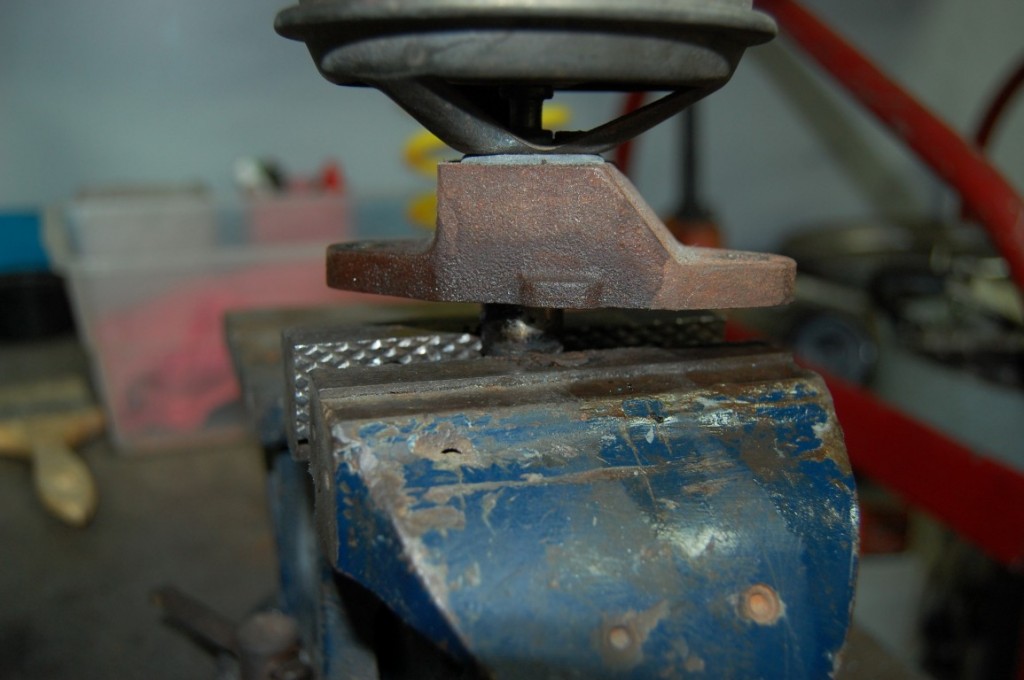 An EGR’s pintle seat can be removed for cleaning. Here the valve is placed in a vise and the upper part of the valve is twisted counter-clockwise. Spraying some throttle body cleaner into the seat’s outer portion helps it rotate easier. It is better yet to soak the entire end in the throttle body cleaner.
An EGR’s pintle seat can be removed for cleaning. Here the valve is placed in a vise and the upper part of the valve is twisted counter-clockwise. Spraying some throttle body cleaner into the seat’s outer portion helps it rotate easier. It is better yet to soak the entire end in the throttle body cleaner.
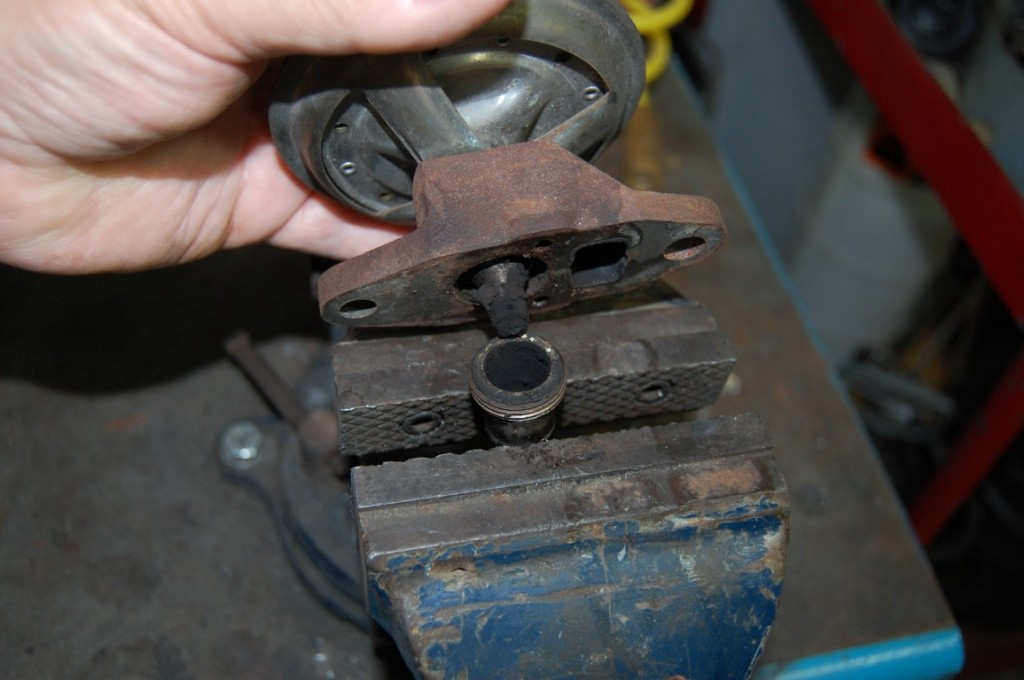 The seat is removed showing just how much carbon can build up on the valves. The flaky deposits can become lodged into the smaller intake manifold ports.
The seat is removed showing just how much carbon can build up on the valves. The flaky deposits can become lodged into the smaller intake manifold ports.
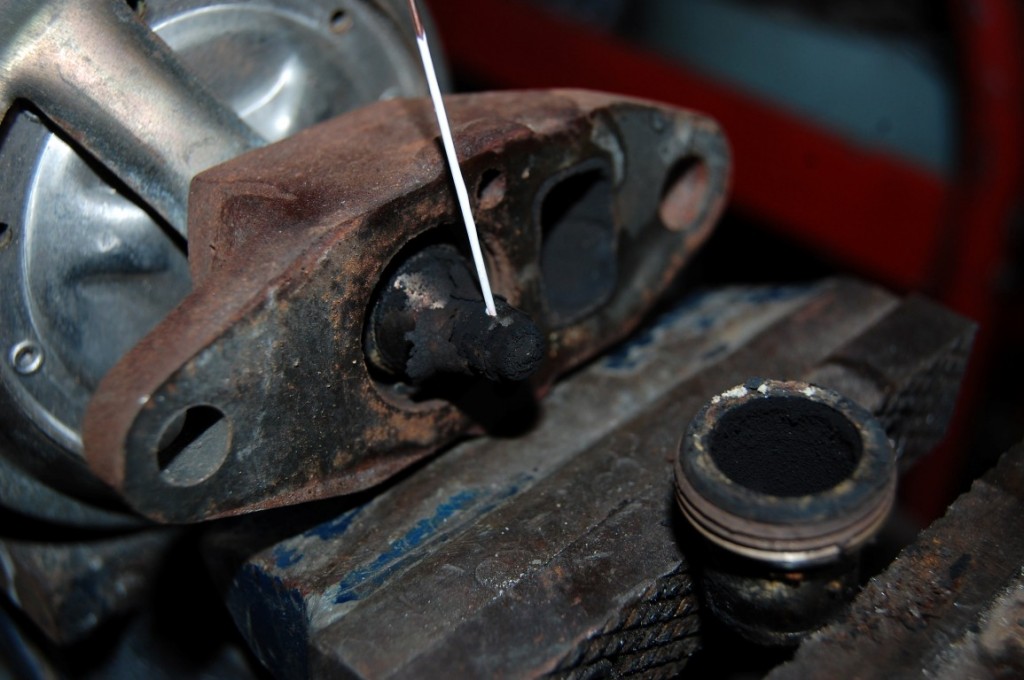 The thin white wire is inserted into the EGR’s pintle exhaust back pressure drilled orifice. This tiny orifice allows exhaust back pressure to react with intake manifold vacuum to control EGR flow. This small port can become plugged and the EGR will hang open.
The thin white wire is inserted into the EGR’s pintle exhaust back pressure drilled orifice. This tiny orifice allows exhaust back pressure to react with intake manifold vacuum to control EGR flow. This small port can become plugged and the EGR will hang open.
EGR valves also come in negative or positive back pressure configurations. The negative back pressure version is used on all of the 1984-1991 Corvette engines. This is a bit of a misnomer in the way that may sound; the EGR valve’s internal check valve will evacuate any vacuum holding the valve open, when the engine is running. The exhaust pressure present in the EGR system will open the check valve closing the valve. It may sound more logical to call it a positive pressure valve but that is way the industry recognizes its operation.
To start with let’s understand the influence the engine has on the EGR valve. On one side of the pintle we have exhaust gas and intake manifold vacuum on the other side. The negative part works like this; with engine vacuum present on the backside of the pintle at road speed it helps to pull open the pintle. The electric control valve solenoid starts the EGR valve movement then engine vacuum and exhaust pressure work to together moving the valve up and down rapidly (dither) to control flow based on engine performance. This pulsing action prevents too much EGR gas from entering the engine and causing an overly lean condition.
GM did not have to monitor EGR operation closely on the 1984 vehicles so there is no Service Engine Soon (SES) light illuminated if the system fails. The 1985-1989 Corvette was a different story. If there were any EGR problems, the SES light came on and coded a 32, EGR failure. To monitor EGR flow on the 1985-1989 Corvettes, another system was added to monitor exhaust heat. If the EGR valve opened and flow occured the in-line temperature switch would close the NO switch and all was good. For 1985 and early 1986 engines with cast iron cylinder heads the switch was placed in the EGR valve itself to monitor the flow at the valve.
1986-1989
For late 1986 and all convertible Corvettes, aluminum cylinder heads were introduced with no internal exhaust passages for EGR to flow. A tube was used to connect the exhaust manifold to the intake manifold with a temp switch at the top of the tube close to the intake manifold. The switch performed the same function- monitoring the heat in the tube. No flow = no heat. Code 32 would be set and the SES light illuminated. This system would be used until 1989 with one running change. The infernal metal squeeze clamps retaining the tube to the exhaust manifold were replaced in 1987 with a bolt-on flange making it much easier to service.
For the 1990-1996 EGR systems the switch was dropped and the ECM would monitor the oxygen sensor reading. The ECM watched for the fuel system to lean out as the valve opened during a predetermined test procedure in the ECM software. This is the way all late model engines monitor EGR operation, if so equipped. The “if so equipped” mention concerns the 1996 LT4 engine that does not use an EGR valve. The camshaft overlap provides enough EGR to satisfy the feds and keep the cylinder temperature in check.
Testing the EGR System
Let’s begin with a very basic test. The exhaust gas must flow as explained earlier to let the ECM know the event occurred or the SES light will be illuminated. Start the engine and attempt to move the EGR valve’s diaphragm manually with a screwdriver on the 1992-1996 LT1 engines or angled screwdriver when trying to access the L-98 1985-1991 valves. When the valve is unseated, the engine should run rough, and the further you push the valve’s diaphragm inward rougher running and/or stalling may occur. If the engine runs smooth or only a minor change in idle occurs, chances are the exhaust ports are choked with black sooty carbon deposits impeding flow. Carbon blocked exhaust gas flow usually occurs after 75K miles depending on driving habits (not necessarily style). Even if you are always hard on the throttle it does not mean that carbon build-up won’t occur, in fact it could happen quicker because you are not letting the EGR system flow. The EGR system does not allow flow when the throttle is rapidly increased to full throttle. Corvettes that are driven short distances are most likely to develop carbon choked EGR systems as the engines run rich from shorter periods of time in closed-loop fuel control. The engine never gets a long distance run to heat up the exhaust and control the fuel in a leaner closed-loop operation. This basic test must be passed before any other items are checked to avoid a lot of unnecessary work. Sometimes you get lucky and the valve itself is choked with carbon. Other times the exhaust tracts are in need of cleaning. Throttle body cleaner works best to soften the carbon and then long thin stainless steel brushes can be used to manually loosen the gunk.
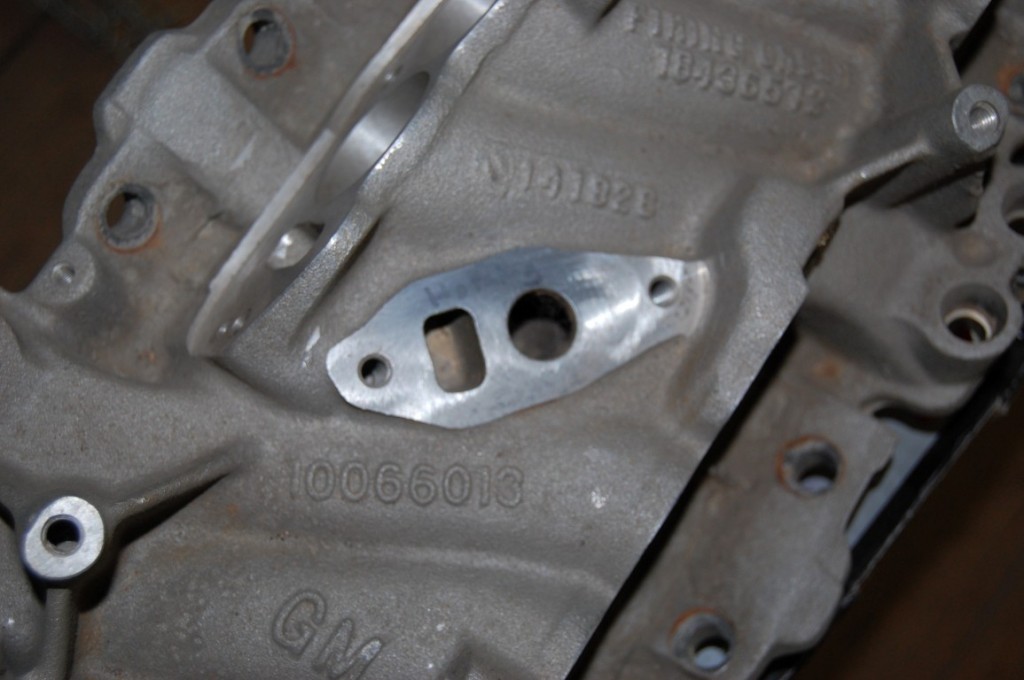 The EGR sits on this portion of the intake manifold; round port is exhaust flowing into valve, rectangular is exhaust out to the engine via the intake manifold ports.
The EGR sits on this portion of the intake manifold; round port is exhaust flowing into valve, rectangular is exhaust out to the engine via the intake manifold ports.
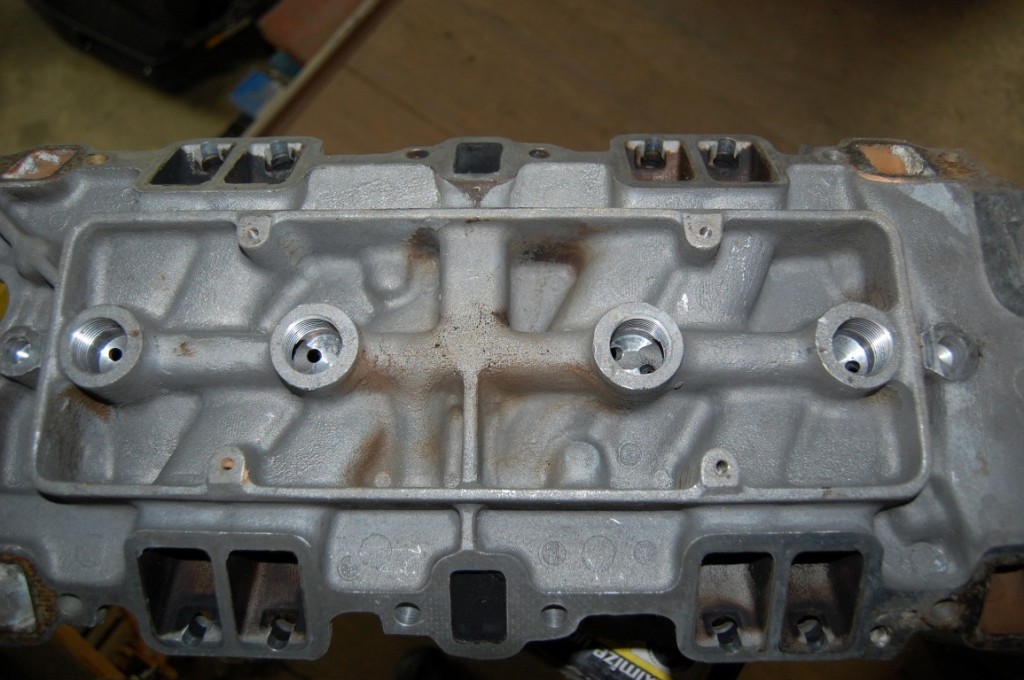 This is the bottom side of a 1985-1986E intake manifold. The large Allen plugs are removed exposing the exhaust gas ports that allow flow into each intake runner. Carbon can build up here and impede or stop flow. Note the center exhaust crossover ports that mate to the cylinder head. On one side you can see the large runner that supplies exhaust gas to the system. Using an incorrect later set of gaskets can block off the center port and no flow will occur.
This is the bottom side of a 1985-1986E intake manifold. The large Allen plugs are removed exposing the exhaust gas ports that allow flow into each intake runner. Carbon can build up here and impede or stop flow. Note the center exhaust crossover ports that mate to the cylinder head. On one side you can see the large runner that supplies exhaust gas to the system. Using an incorrect later set of gaskets can block off the center port and no flow will occur.
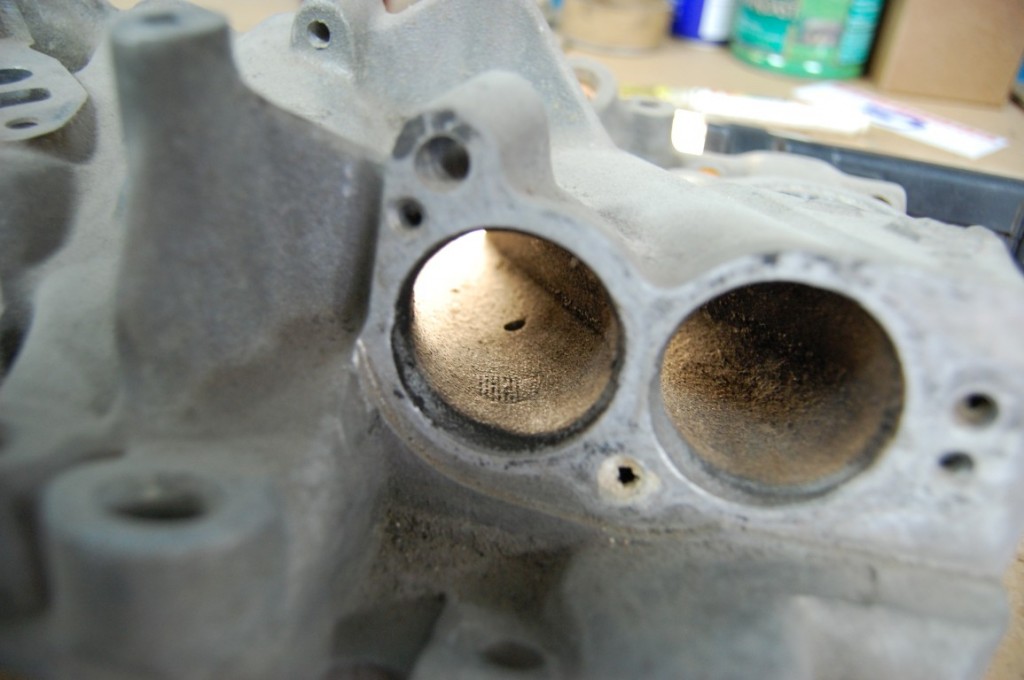 If you look into the intake runner on the left, you can see a small hole drilled into the runner for exhaust gas flow. Each runner has this same drilled orifice that can plug up; this would explain a poorly flowing system.
If you look into the intake runner on the left, you can see a small hole drilled into the runner for exhaust gas flow. Each runner has this same drilled orifice that can plug up; this would explain a poorly flowing system.
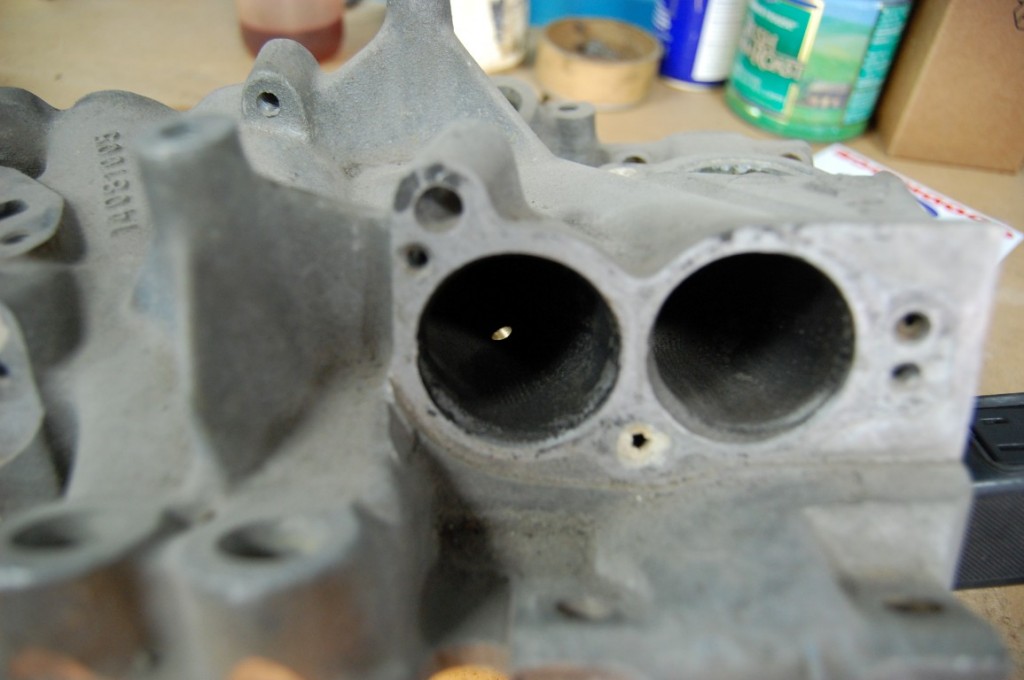 Different lighting showing the orifice size a bit better.
Different lighting showing the orifice size a bit better.
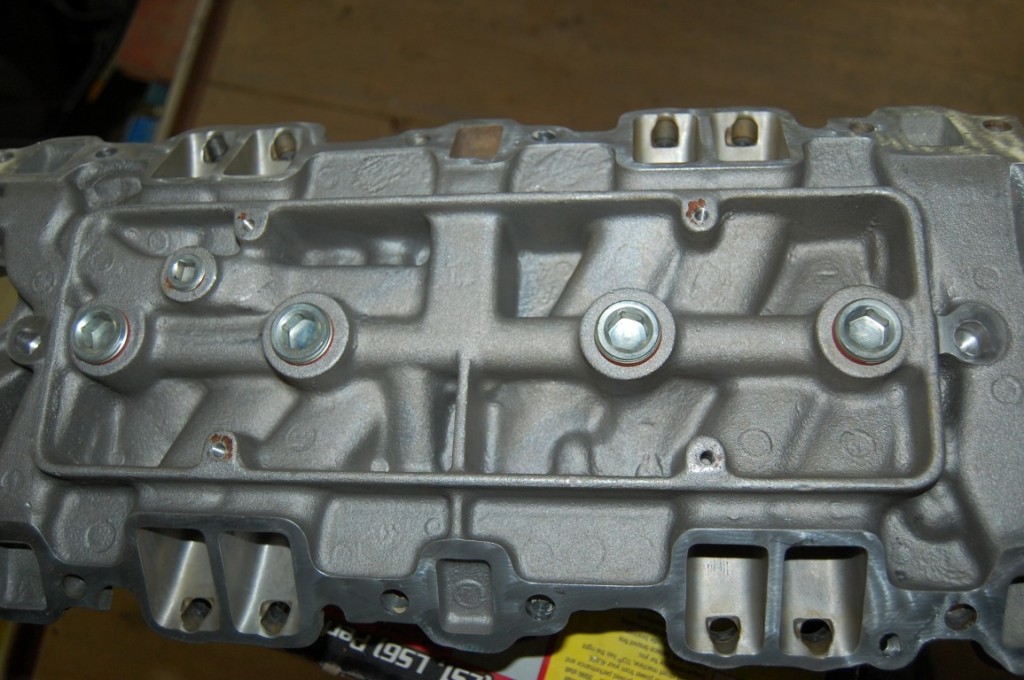 This intake manifold is from a late 1986-1991 Corvette with an additional plugged port. The smaller plug is part of the external tube’s exhaust flow tract. The center port is blocked by the gaskets and does not have any exhaust flowing through it.
This intake manifold is from a late 1986-1991 Corvette with an additional plugged port. The smaller plug is part of the external tube’s exhaust flow tract. The center port is blocked by the gaskets and does not have any exhaust flowing through it.
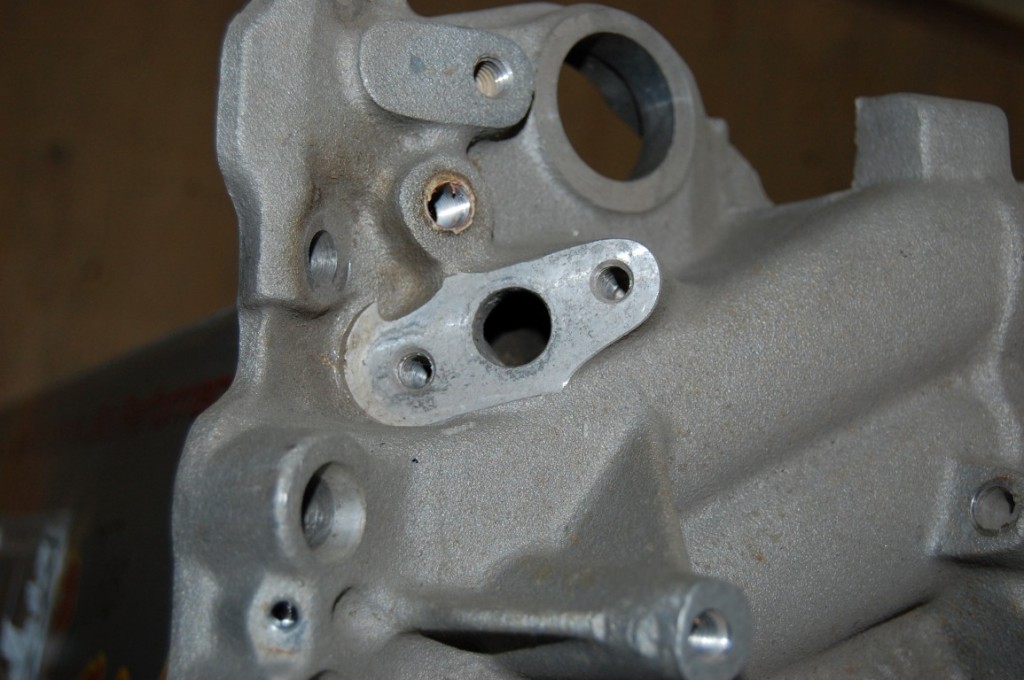 The 1986L-1991 EGR tube connects at the somewhat oval flange with two 8MM screws near the distributor on the passenger side.
The 1986L-1991 EGR tube connects at the somewhat oval flange with two 8MM screws near the distributor on the passenger side.
Testing Tip 1984-1986E Corvettes
A tough one to diagnose is a code 32 after an intake gasket replacement on the 1984-1986E Corvette; incorrect gaskets can block the EGR’s exhaust flow through the cylinder head. This pertains to any 1984-1986E Corvette with cast iron cylinder heads.
Testing Tip 1985-1989 Corvettes
One of the toughest systems to diagnose is the 1985-1989 with the temperature switch monitoring flow. Either one of the switches can fail (or the EGR system could be the culprit), not allowing flow and illuminating the SES light coding 32. Here are some field observations: I have found when the SES light comes on immediately at start-up with code 32, the EGR temperature switch has failed in the closed position indicating exhaust heat when the engine is first started. The engine can also be at operating temperature and the SES light will come on, although the engine is at operating temperature the exhaust flow would not be hot enough to open the switch at startup. So, if the SES light comes on immediately at startup check the temperature switch for a closed circuit. Disconnect the switch’s connector and connect an ohm meter to the switch’s wire lead and a good ground on the engine. If the meter shows a closed circuit, you found the problem. If the SES light is coming on after the engine is warmed and you have been driving on the highway for more than ten miles there could be multiple culprits. The temp switch could have failed not closing once the EGR valve has opened or the valve has not opened allowing EGR flow. The most common problem seen is that the EGR valve or the switch has failed. A quick check of the temp switch can be done on the 1986-1989 Corvettes by heating it up and monitoring it with the ohm meter connected in the same fashion as the first test. I use a professional model heat gun to heat the switch; hair dryers may not supply enough heat to close the switch. The switch requires approximately 550-700 degrees of direct heat to close, completing the circuit to the ECM.
 The temperature switch on the right would be found on 1985-1986E engines with cast iron cylinder heads screwed directly into the EGR valve. 1986L-1989 engines have the switch installed in the EGR transfer tube between the exhaust and intake manifolds.
The temperature switch on the right would be found on 1985-1986E engines with cast iron cylinder heads screwed directly into the EGR valve. 1986L-1989 engines have the switch installed in the EGR transfer tube between the exhaust and intake manifolds.
EGR Valve Test
The next phase would be to test the valve itself. The 1984-1996 EGR valve works like this: the EGR valve’s pintle should rise when applying vacuum with a hand operated pump. 1984 EGR valve operation can be felt with your fingers as vacuum is applied. We use a mirror to check the 1985-1991 EGR valves’ operation. LT EGR valves can be seen easily as vacuum is applied. Once vacuum is applied the diaphragm should rise, holding vacuum until the engine is started, then the valve should purge the vacuum and the valve will close. If the valve should fail to rise during vacuum application, the valve has an open check valve or broken diaphragm. Replacement is the only option, making sure to use the correct size orifice valve. Therefore, not just any valve will work that bolts in place due to exhaust flow volume. On the other hand if the valve does not close when the engine is started the EGR’s internal check valve is either stuck closed or the exhaust pressure passages in the valve are clogged. Many times the EGR valve has failed. The best policy though is to check its operation before dumping it.
 The 1990-1991 Corvette has the MAP sensor blocking the already difficult to access EGR valve. I remove the 10mm bolt holding the sensor for a bit more access. Keep the vacuum tube connected if you plan on running the engine; if left off, expect heavy black smoke from an extremely rich running engine.
The 1990-1991 Corvette has the MAP sensor blocking the already difficult to access EGR valve. I remove the 10mm bolt holding the sensor for a bit more access. Keep the vacuum tube connected if you plan on running the engine; if left off, expect heavy black smoke from an extremely rich running engine.
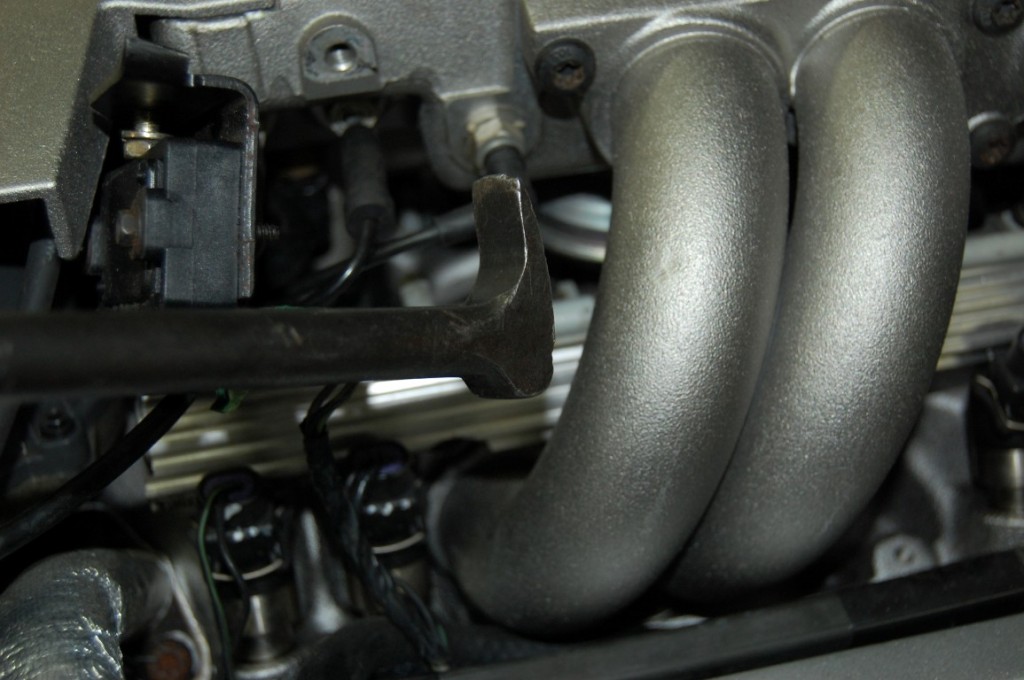 This is the bar I use to move the valve. Any tool shaped in this manner will allow you to raise the valve.
This is the bar I use to move the valve. Any tool shaped in this manner will allow you to raise the valve.
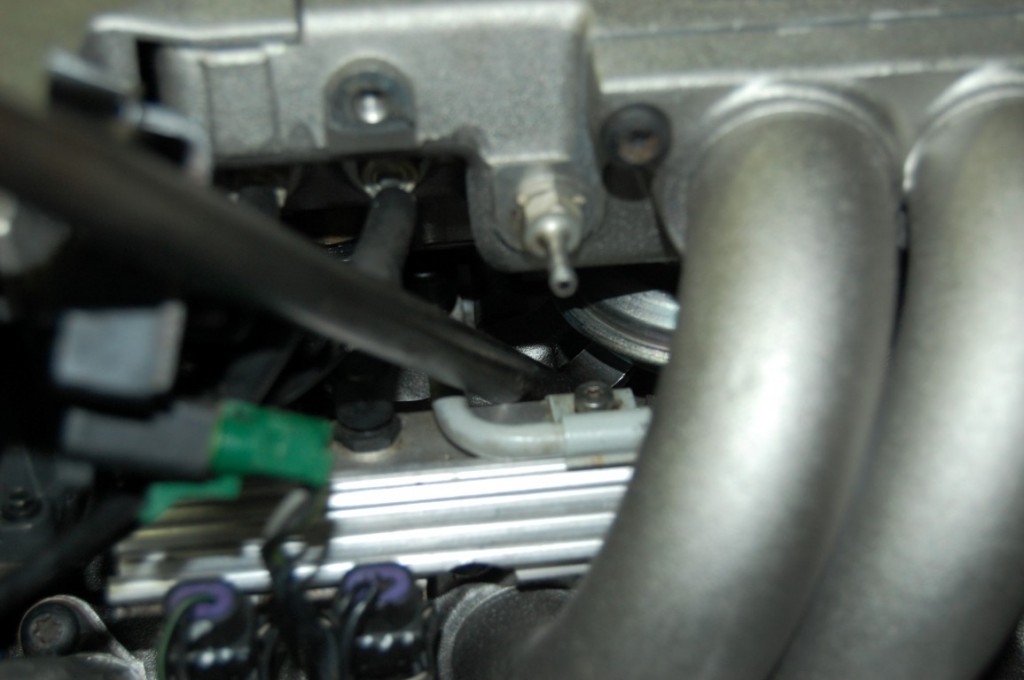 The “crowfoot bar” is placed in this position to move the valve. When the valve is lifted, expect the engine to run rough. If lifted high enough, the engine may stall.
The “crowfoot bar” is placed in this position to move the valve. When the valve is lifted, expect the engine to run rough. If lifted high enough, the engine may stall.
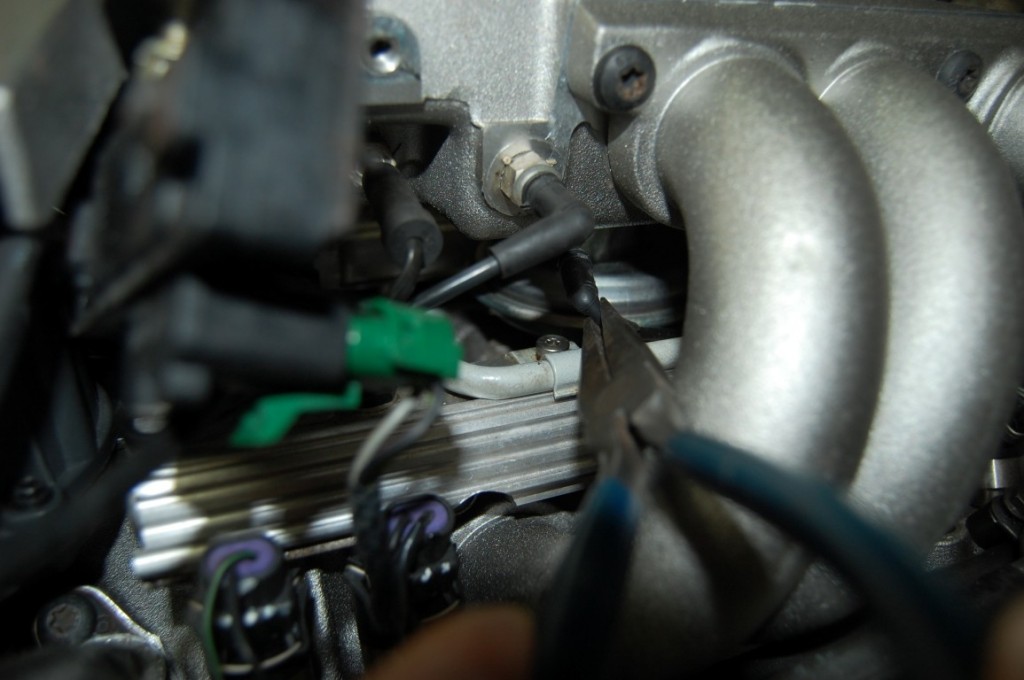 Here the vacuum tube connector is being removed from the hidden EGR valve; this pair of needle nose pliers works well. Twisting the connector before trying to remove usually prevents damage.
Here the vacuum tube connector is being removed from the hidden EGR valve; this pair of needle nose pliers works well. Twisting the connector before trying to remove usually prevents damage.
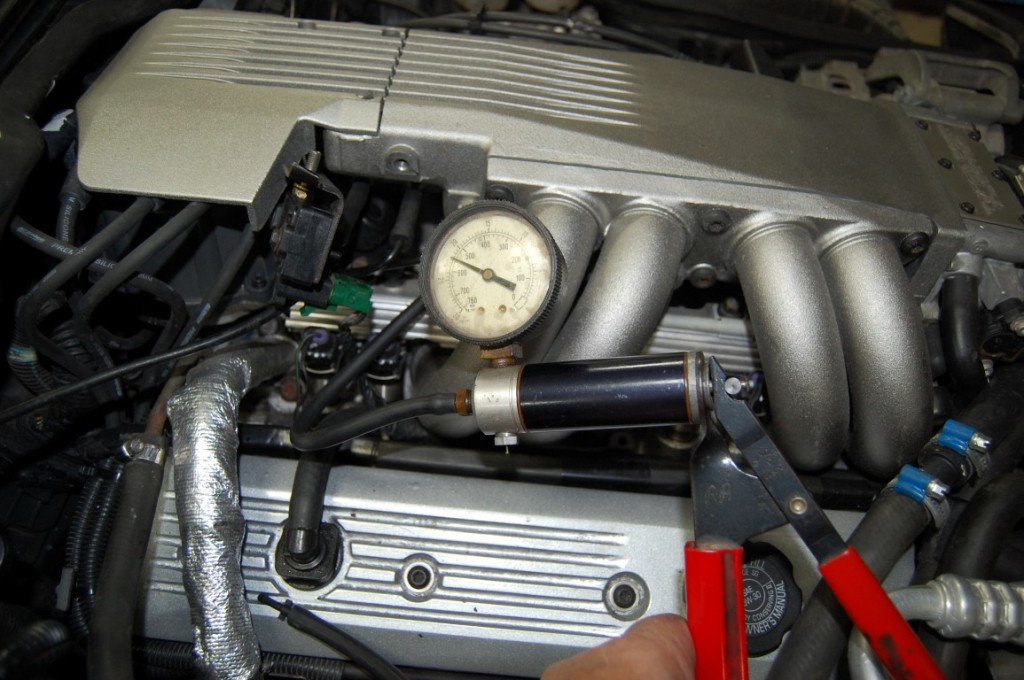 The hand operated vacuum pump has been able to pump up to 20″ of vacuum and hold for five minutes, telling me the valve is functioning correctly so far.
The hand operated vacuum pump has been able to pump up to 20″ of vacuum and hold for five minutes, telling me the valve is functioning correctly so far.
Testing the EGR Vacuum Control Solenoid
The 1984 and 1990-1996 Corvettes use a NC control valve solenoid that blocks vacuum flow until the ECM or PCM applies an electrical ground to open the valve. A failing control valve solenoid can cause stalling and poor or very rough idle on the 1984 Corvette Crossfire engine. The 1984 engine uses a manifold vacuum source to operate the EGR valve so a strong vacuum flow from a stuck open control valve solenoid would allow EGR to flow at idle. This would occur after a drive cycle coming to a stop. For instance, the valve would hang open from the engine vacuum preset on the pintle, either slightly causing a rough idle or stalling. Once the rough running engine manifold vacuum drops, the valve would close and all would be good again until the next drive cycle. A failed control valve solenoid on the 1990-1996 Corvettes would prevent EGR valve operation, turn on the SES light, and set a code 32 in memory. To date many of these NC control valve solenoids have been replaced in an effort to fix a code 32 with poor results. In the shop, I have never replaced a control valve solenoid unless it was physically damaged during other engine repairs; they have a very good reliability record.
All 1985-1989 Corvettes use NO control valve solenoids. 1985-1989 Corvettes use a ported vacuum source to open the EGR valve and the SES light would not be illuminated if the control valve solenoid stayed open. The performance would be affected if the control valve solenoid was stuck open and the small orifices in the pintle became plugged. The EGR valve pintle would hang open causing uncontrolled EGR flow. It was discussed earlier how the pintle allows exhaust pressure to open the check valve and close the valve. If those orifices became plugged the valve will open with any vacuum source applied and stay open. Engine performance would suffer from hesitation, lack of power, and overall poor performance with the uncontrolled EGR flow.
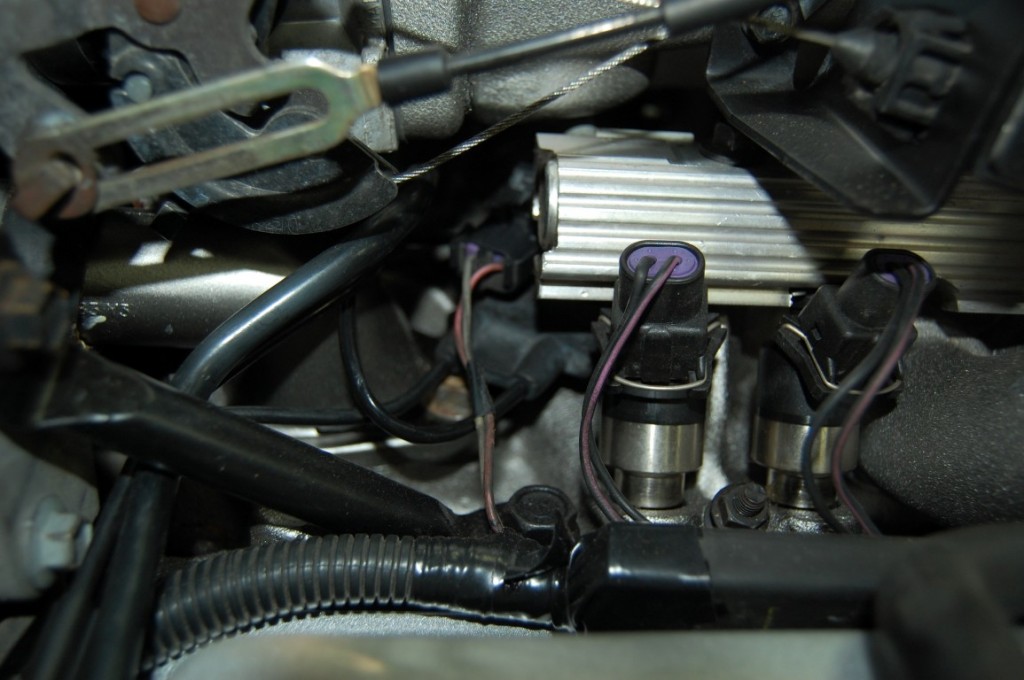 The EGR solenoid is buried under the plenum in front of the cylinder number one fuel injector. A 9/16″ hex head bolt that retains the water outlet is used to mount the solenoid’s bracket. A vacuum tube assembly connects the solenoid to the EGR valve and throttle body’s ported vacuum port. Ported meaning vacuum is available when the throttle is opened, not at idle.
The EGR solenoid is buried under the plenum in front of the cylinder number one fuel injector. A 9/16″ hex head bolt that retains the water outlet is used to mount the solenoid’s bracket. A vacuum tube assembly connects the solenoid to the EGR valve and throttle body’s ported vacuum port. Ported meaning vacuum is available when the throttle is opened, not at idle.
 This is where the 1985-1986E solenoid is placed. Note that the vacuum harness connector has a raised portion to prevent incorrect installation of the vacuum connector. The same style connector is used on the 1986L-1991 engines to prevent incorrect installation.
This is where the 1985-1986E solenoid is placed. Note that the vacuum harness connector has a raised portion to prevent incorrect installation of the vacuum connector. The same style connector is used on the 1986L-1991 engines to prevent incorrect installation.
Now, it is possible that dirt or debris could block either the NC or NO control valve solenoid’s operation preventing flow and cause a code 32. The 1984 would not code 32, but a smog test would show high levels of NOx from the blocked solenoid. The control valve solenoid can be checked with a hand operated vacuum pump or any manifold vacuum source. Vacuum is applied to the control valve, then 12 volts and a ground supplied to the solenoid’s terminals should open the valve allowing vacuum flow. Polarity is not a concern as long as the harness connector is off the valve during testing; if you leave the connector on (not recommended), make sure you supply 12 volts on the black/pink striped wire. A simple test of the 1985-1991 control valve solenoids’ operation would be to remove the electrical connector from the valve, start the engine, rev the engine to 1500 RPM, and check for vacuum at the EGR valve connector tube. If you have good vacuum the valve and throttle body vacuum source is not blocked. If no vacuum flows the valve is plugged, the tubing has leaks, or the throttle body has a blocked passage. Opposite of the 1984’s system, when 12 volts and ground are supplied to the solenoid, the vacuum should be blocked during testing.
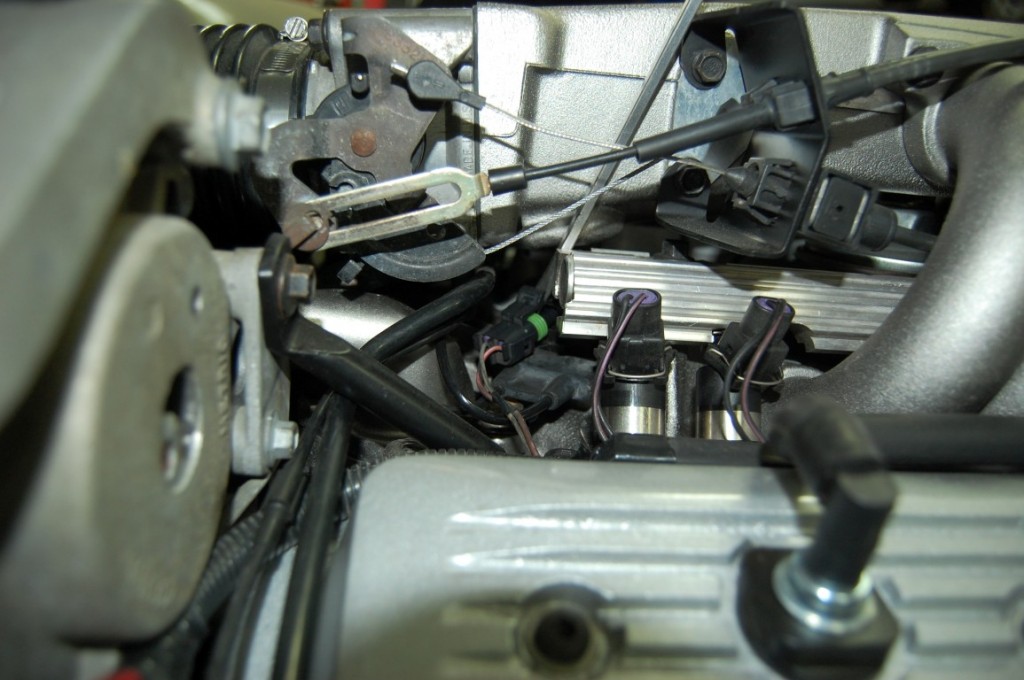 If you look closely, you can see the long thin screwdriver is used to push off the EGR control valve solenoid’s connector for testing.
If you look closely, you can see the long thin screwdriver is used to push off the EGR control valve solenoid’s connector for testing.
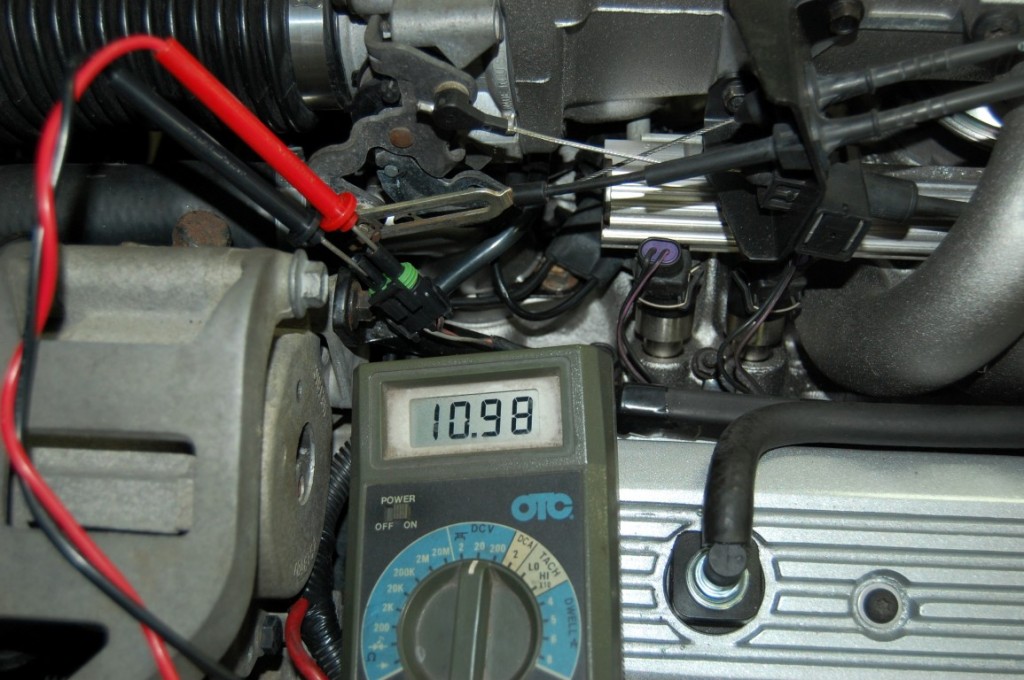 This 1990 NC EGR control valve solenoid is being tested for ignition and ECM ground with the ignition key on, engine off. The voltage reading is correct but the battery is low. We should normally see 12.0 volts with a fully charged battery.
This 1990 NC EGR control valve solenoid is being tested for ignition and ECM ground with the ignition key on, engine off. The voltage reading is correct but the battery is low. We should normally see 12.0 volts with a fully charged battery.
The 1990-1996s could have a failed NC control valve solenoid, preventing opening and flow. Unlike the 1985-1991 systems they use manifold vacuum which would have vacuum present at the valve while the engine is running. Like the 1984 the solenoid can be tested in the same manner using 12 volts and ground. Once we have determined that the EGR valve and control valve operate properly with a clean EGR system, our next test is to connect a vacuum gauge to the EGR valve’s vacuum supply tube at the valve. With a long hose connected to our vacuum gauge and at the EGR valve connector, the gauge is placed so we can read it from the driver’s seat. A road test will determine if we have vacuum at the valve at cruising speed. If so, we know the control valve solenoid is functioning and the ported vacuum supply is there. If there was no vacuum at cruise we need to check the control valve and vacuum supply.
Cracked tubing is a very real possibility from years of under hood heat. Also check all the tubes and fittings for proper fit. Any suspect tubing should be replaced. If you are careful, a heat gun can be used to put the bends in the tubing as they were originally. This is where a hair dryer may be more useful; it may not melt the tubing whereas the heat gun can easily turn it into a glob of goo. Now if we have vacuum during our test the next step is to tee the same vacuum gauge into the EGR system near the EGR valve. A road test will determine if we have vacuum present at the valve during a steady throttle (opening usually between 35-45 MPH). If we have 10-14 inches of vacuum at cruise the entire EGR system is working, signifying that there is a problem with blocked exhaust gas flow through the intake side of the system. If the system was checked for flow early on as discussed, there is a problem with the engine’s performance- worn piston rings, running too rich or lean.
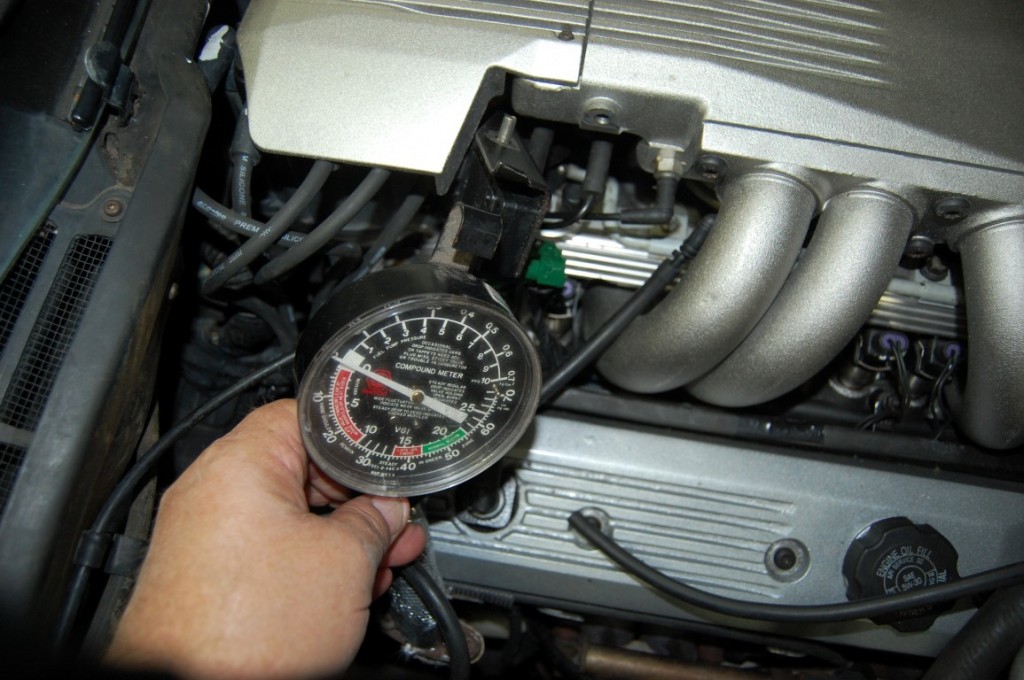 Now a vacuum gauge is installed with a tee connecting the valve in-line with the gauge for the next test.
Now a vacuum gauge is installed with a tee connecting the valve in-line with the gauge for the next test.
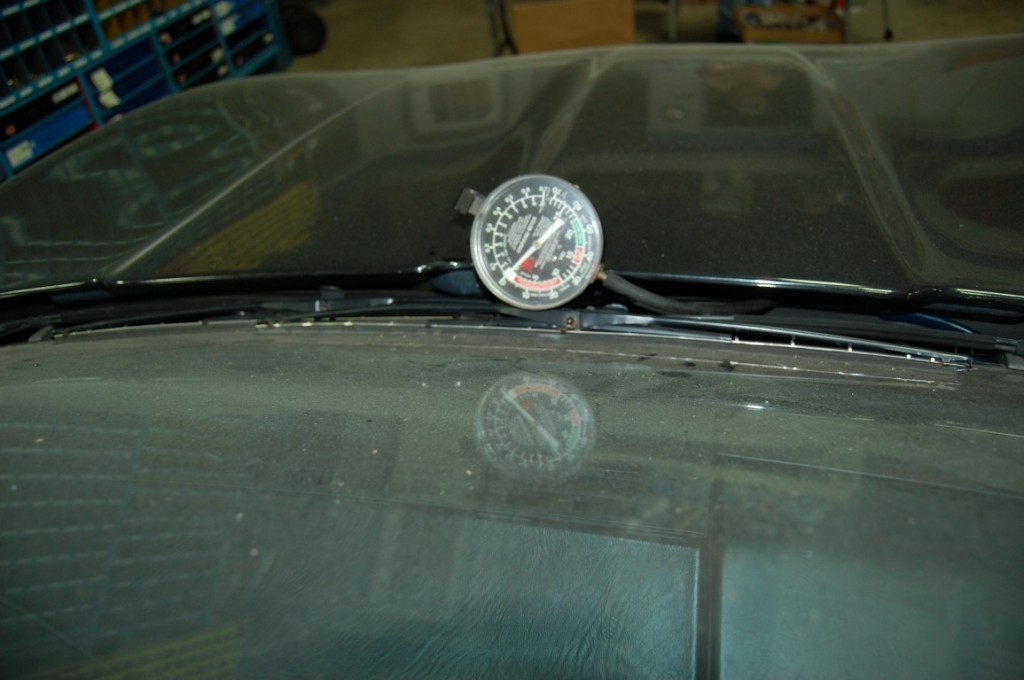 The hood is closed and a road test is next to see if vacuum flowed or not per our troubleshooting info.
The hood is closed and a road test is next to see if vacuum flowed or not per our troubleshooting info.
If there was no vacuum present during the drive cycle while there was on the prior test, exhaust system backpressure is most likely the problem. A free flowing exhaust system on a 1990-1996 can affect the pressure on the exhaust system limiting the check valve’s operation. The reduced pressure would not allow the EGR valve to open. In this case I have blocked some of the check valves holes that are used to dump vacuum. Usually blocking half of the typical six holes will get the EGR valve operating again while still allowing control of the valve, preventing too much flow.
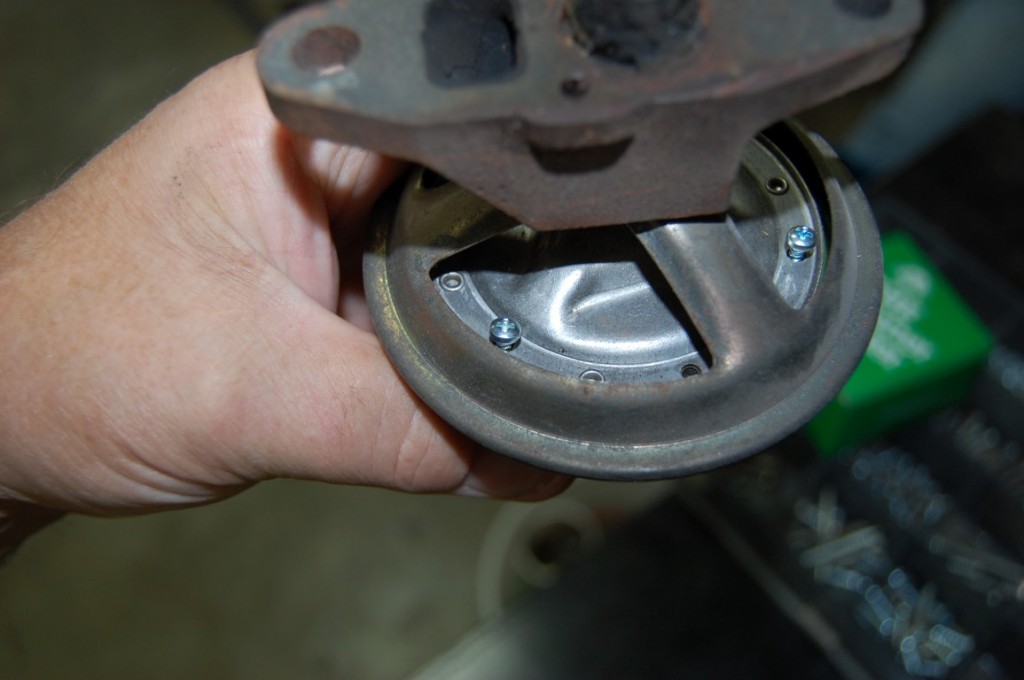 Here we have an EGR valve with screws installed, blocking some of the negative backpressure check valve’s ports.
Here we have an EGR valve with screws installed, blocking some of the negative backpressure check valve’s ports.
Corvette Central has a wide selection of EGR valves and EGR temp switches to solve any EGR issue you may have.
Story and photos courtesy Chris Petris

Hi,
I have the 1991 convertible C4 and just made the road test as described. So if I connect only the solenoid to the vacuum Gauge it keeps the vacuum constantly about 14 inches.
When tee connected to the valve, it creates the vacuum up to max. 12 inch, but it cannot keep it all the time up, sometimes it just drops to 0 for a second and comes back.
Is this also a backpressure thing?
Hi,
I have the 1991 convertible C4 and just made the road test as described. So if I connect only the solenoid to the vacuum Gauge it keeps the vacuum constantly about 14 inches.
When tee connected to the valve, it creates the vacuum up to max. 12 inch, but it cannot keep it all the time up, sometimes it just drops to 0 for a second and comes back.
Is this also a backpressure thing?
I’m trying to clean a Corvette intake. A 91 with rails attaching injectors to ports.. Two large openings in front . Besides having to remove a load of stuff to put into hot tank, When I looked inside inoticed two 3/8 holes in floor directly below front opening and above a barb that looks like it was vacuum. I think exhaust has breached plenum floor.
My 1990 pops the SES light when cruising on the highway, code 32, all the time, and it recently failed emissions testing with high NOX.
Per my FSM, and the info in the article above, my solenoid should be NC ‘normally closed’.
When I blow on either port, with the solenoid removed from the car (ECM and vacuum lines disconnected) air flows freely. I’m expecting air flow to be blocked by the solenoid in this disconnected state if it is supposed to be NC, am I wrong?
My EGR Solenoid is stamped with numbers DR 195, 1110.
Either I have a wrong, NO ‘Normally Open’ solenoid, or I have the right one but my NC solenoid is stuck open, right?
same here, ‘91. There is 12V while idling or ignition is on and the solenoid opens when it is disconnected so it must be NO type
Hey everyone i have a 1992 corvette with the lt1 my engine light came on when i was driving the other day i pulled the codes i got h32 Witch is something todo with the egr system i got the egr solenoid replaced a few months ago is my egr valve bad ? The engine light turns off when i shut the car off for a few minutes and the car runs rough when I’m at a red light feel it mostly in the back of the car really could use some help.
I would recommend taking the car to an experienced Corvette technician to be diagnosed.
I’ll be so happy when I finally convert my 87 convertible to electric. No more gas, oil, and carbon infested EGR system.
Great EGR repair tutorial! Thanks for posting it!
Here’s a video of my 87…
https://www.youtube.com/watch?v=tWwTNqDNtBw
This is the best, most comprehensive and well written be-all, end-all article for these EGR systems- THANK YOU! I am struggling with a newly rebuilt L98 B2T in a 1989 3rd Gen IROC convertible that has been my project for the last four years. The holy grail is to be able to pass the CA emissions test. Which I have been unable to pass, but close, on high NOx (700ppm). New CalCat, new EGR valve, temp sensor, new vac lines, tested the solenoid (appears good). Stock L98 with 91 flat top pistons (10:1 -ish), mild cam, Bosch D3, with custom tune so I think I am setup to pass. Car runs like a new one. So fun. BUT, gotta bring that NOx down. I will read this article several times before taking the next step. Two things- I am not sure where I am supposed to pickup vacuum to the solenoid so I will research that carefully (I never was aware of the difference between ported vacuum and manifold vacuum). Right now it’s just coming off at the back next to the FPR vacuum (which I believe is manifold vacuum). Second, I never checked the injection ports and chambers in the intake manifold. I never what they were! Anyway, thanks VERY MUCH. I am encouraged that I feel like I can conquer one of the most annoying systems on these cars.
I have a 94 ZR1 Corvette and it has set a code 32 twice recently. I have a Actron scanner that was top of the line quite a few years ago. The weird part is that the workshop manual doesn’t list the code 32. My scanner tells me what it is etc. Once the SES light comes on in the ZR1 the power switch is deactivated and the secondary injectors won’t work. The car seems to run great, no hesitation or anything. I recently just did have the plenum off and replaced all the coils, wires and injectors, so I am wondering of course if a hose or, I believe, that there is an EGR switch under the plenum? HELP!!!!!!
Hello,
I have a stock 1990 Corvette. I get “Code 32” after 20 minutes on the highway. I have replaced the:
– EGR Valve
– MAP Sensor
– O2 Sensor (Bosch)
– MAP Sensor
I keep reading about the EGR temperature switch and the EGR solenoid (though I am not sure a 1990 has one) Any suggestions?
Thanks
89 corvette at idle after it warms runs up and down. Put in gear runs smooth. TPS ?
I have an 89 Corvette coupe I will need to have the EGR valve replace today but after reading this I believe I should have them replaced the switch as well getting the vet ready to sell this summer thanks for the advice
1993 LT1… Sometimes but not all the time. …for the first start up in the morning after it starts I hear a pop sound. Starting around the third or fourth ignition start after the engine has heat it up, the idol will go down to 500 and below in stall out the engine. Then I will start it again and keep Excelerator down to 1000 RPM to keep it running for about 15/22 and then let go of the pedal in a little eventually I all had 500 or 600 RPM starting around the third or fourth ignition start after the engine has heat it up, the idle will go down to 500 and below in stall out the engine. Then I will start it again and keep the Excelerator down to 1000 RPM to keep it running for about 15/22 and then let go of the pedal in a little eventually I all had 500 or 600 RPM .
My problem is not being able find a 1986 EGR vacuum assembly. No one in this country manufactures that component. What do you suggest? The junk yard will only sell the complete engine for 1500.00 dollars. I have a brand new rebuild engine. Please advise and thank you.
I agree, I am not aware of anyone making these. You will have to continue to try and source the part used if you plan to stick with your stock engine. There are some good C4 salvage yards that may have what you need. Try vette2vette.com, Taber Corvette Parts, Corvette Recycling, AES Corvette Parts, Mirrock Corvette, and Contemporary Corvette.
Thank You the information CC TECH. I will check these salvage yards and see what happens. Also I will inform you on what happens in my search.
Hi,
very good description, thank you.
I have a question, if the engine would habe a problem with performance- worn piston rings, running too rich or lean (as described). Then it would cause more problems than only the EGR, right?
There’s one on eBay! Search under 1986 corvette egr solenoid vacuum lines. $124.00 free shipping! It’s a 86 only assembly and they do not remake it
I have a 1988 Corvette, the Egr valve has three connection. I know where two small vacuum Connection come from the vacuum cannister. But the big one, the one on the other side of the wire connector I cannot seem to fine where it goes. Can you please tell me the where it route to.
I have the same question. Did you ever get an answer?
That’s a vacuum relief port. It lets the EGR valve relax after it has been activated. Nothing goes there except a small piece of rubber foam to act as an air filter. Usually that piece of foam dissolves into nothingness over time.
Hi I have a stock 92 corvette after driving for 20 minutes engine light turns on I replaced egr valve and egr solenoid could it be my evap solenoid
My first questions would be “What code(s) are set in the ECM? Have you had it scanned?”
Gus Gustafson
Product Assistance
Corvette Central
800 345-4122
I have a 92 stock Corvette LT1 and once the engine heats up at idle it will surge from 500 to 1200 rpm at a light while in drive and then sometimes it will stall out. I’ve been frustrated with this for a long time. A Chevy dealer soaked me with all new injectors and fuel pump it worked for a while but still does the same thing. Could it be the egr valve?
Have you scanned the computer to see what codes it may have?
I have a ’92 Lingenfelter manual car, with the exact same issues. I’ve worked on it myself, and had it to several shops. Probably spent at least $2,000 on it. As you say, new injectors and whatnot will cure it temporarily, but then the problem comes right back. I’ve been trying to figure out how to convert to a later ECM.
My 85 was doing the same thing. I replaced the throttle position sensor and that took care of my problem.
Have a minor problem with EGR tube in an ’87 with aluminum heads, the FSM and other books are missing what torque is required on the 8 mm screws. Anyone have a suggestion what the torque should be?
The small holes in the intake runners are not for EGR. They are part of the vacuum passages and connect to the hose barb for the PCV valve. They are also used by the cold start injector. I have an early ’86 Corvette with cast iron heads. It DOES have an EGR tube from the exhaust manifold to the intake manifold. The EGR passage from the passenger side head joins with the passage from the EGR tube. The EGR temperature switch is located in the EGR tube, not in the EGR valve.
Absolutely correct. I noticed this was wrong in the write up. Otherwise, great.
I came across this link. Very interesting write up. I’ve been having some surging and stalling issues with my 88 L98 that I installed in my El Camino. Every single emission control or component has been installed and wired. It has run flawlessly since I installed it around 2000. It’s a Camaro motor with iron heads and roller rockers. Pretty much stock except for an aftermarket chip. I swapped the chip out to a stock 305 chip just to see if it might be due to the chip. I just did that today. I realize there may be performance issues swapping the chip but I thought I’d try it anyway. I found a code32 a few days ago. I found an open in my egr solenoid circuit that I repaired. Being a NO solenoid I found it very interesting that vacuum passes when it’s not energized. I think my egr temp switch is grounded since I was unable to see voltage at the ecm on C15. I’ll disconnect it and see if the voltage can be measured. If so, I guess I’ll be replacing the temp switch but I’ll look for a ground before I pull the plenum.